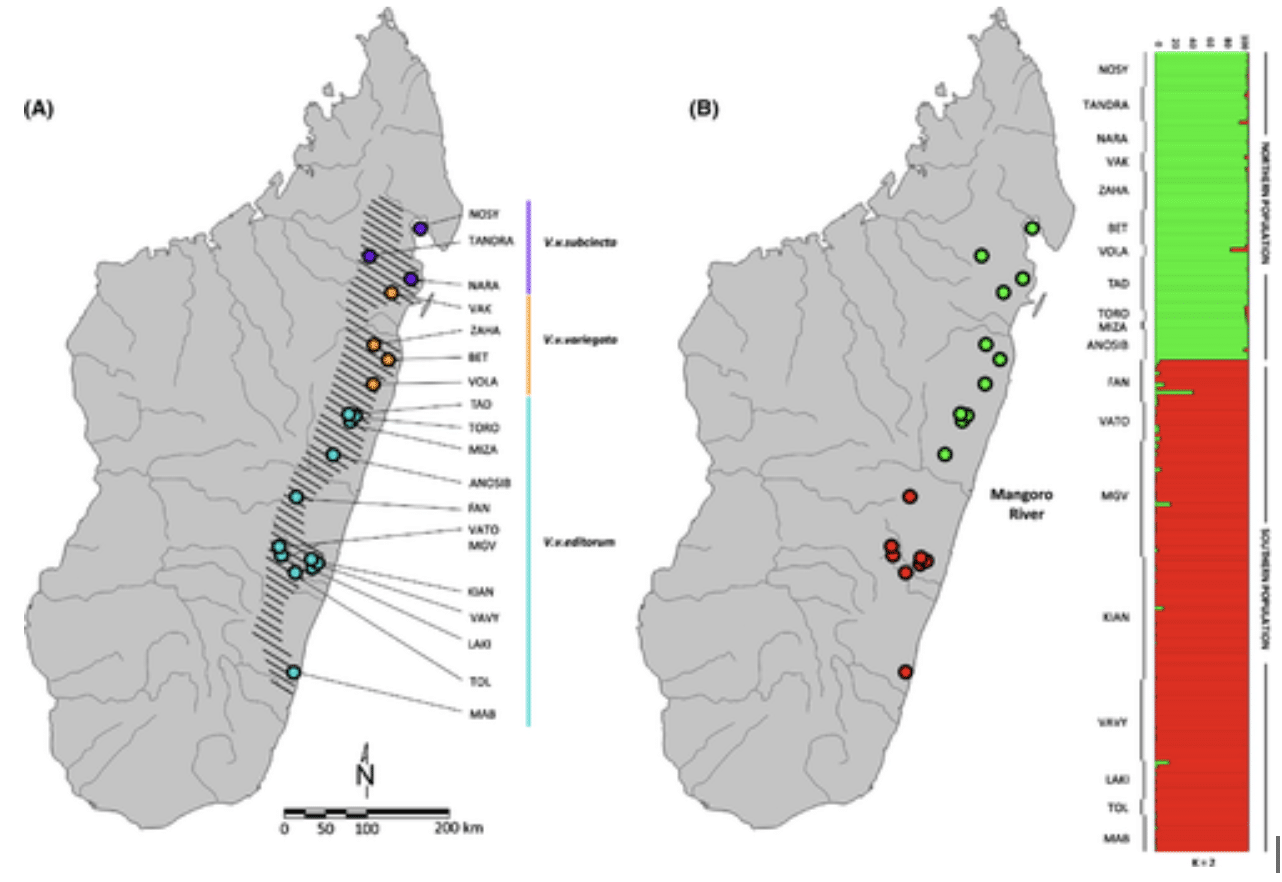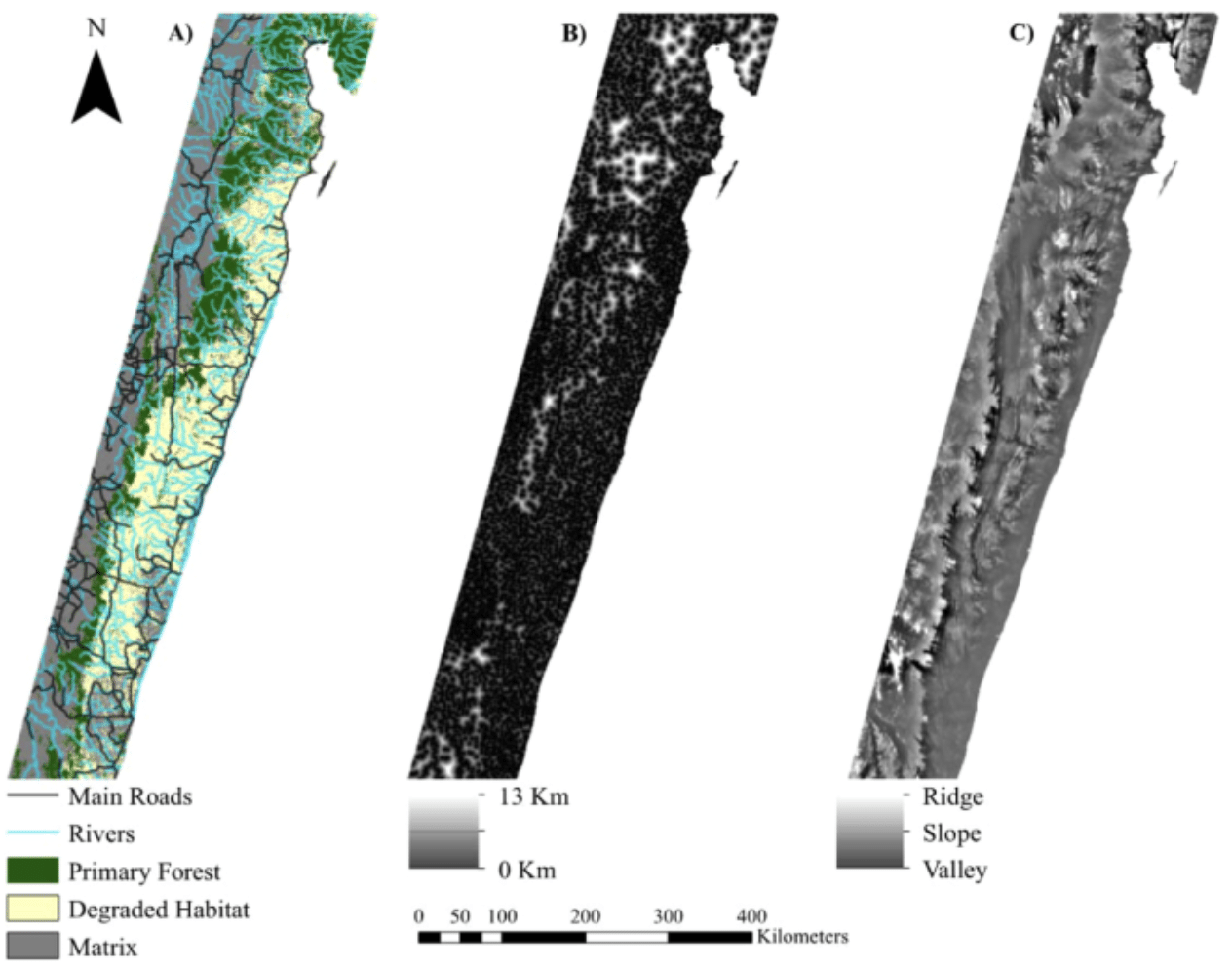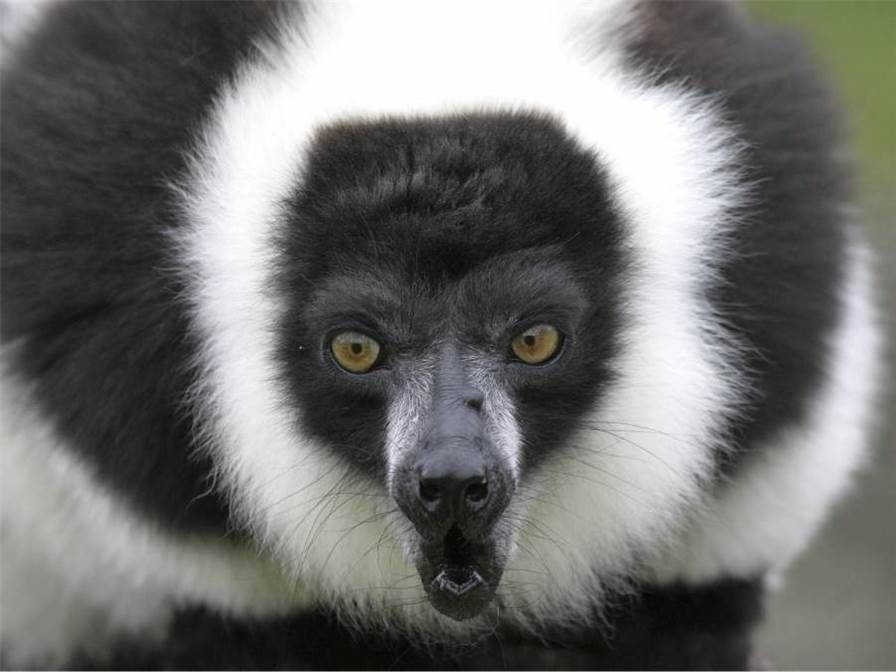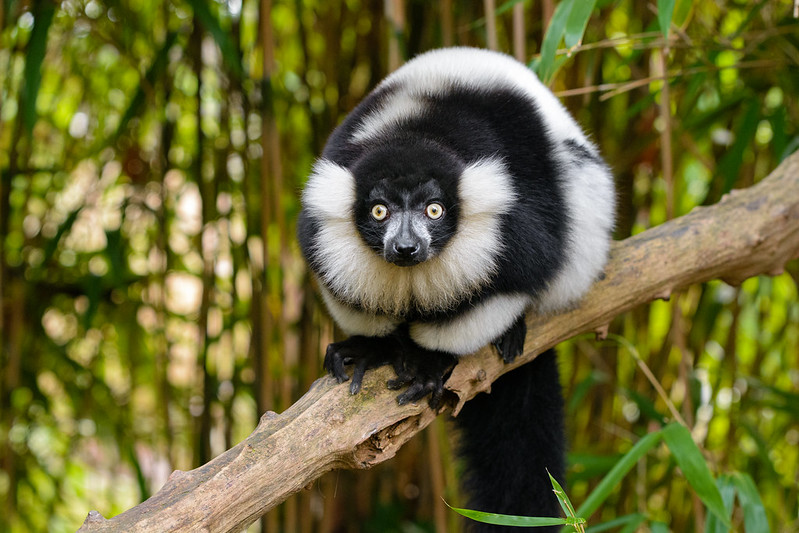In this post of our Science Corner series, Kate Cioffi, MS reviews three scientific papers about conservation genetics and examines their importance for ruffed lemur conservation.
Learn about genetics and how they signal hope in the conservation of ruffed lemurs, our featured species in the World Lemur Day 2024 logo!
The papers discussed in this post are:
- “Species-level view of population structure and gene flow for a critically endangered primate (Varecia variegata)” published in Ecology and Evolution
- “Anthropogenic pressures drive population genetic structuring across a Critically Endangered lemur species range” published in Nature Scientific Reports
- “The mitochondrial DNA diversity of captive ruffed lemurs (Varecia spp.): implications for conservation” published in Oryx

What Can Genetics Tell Us About a Species?
Genes are packages of hereditary information (DNA) that are passed down to offspring. They determine biological traits. At the population level, there can be changes in genes (genetic variation) between individuals that help scientists learn about the overall genetic diversity of a species. This information can be valuable for guiding biodiversity conservation strategies.
Genetic structure refers to how genetic variation is distributed among a particular population. This is impacted by factors like gene flow, or how genetic material moves between populations. If gene flow is impeded, a population may experience what is known as genetic isolation. This can lead to genetic differentiation, or the accumulation of genetic variation in a population over time. This forms the field of conservation genetics, which studies genetics to protect species.
Why Look at Ruffed Lemurs?
Dispersed along the eastern rainforest corridor of Madagascar, black-and-white ruffed lemurs (Varecia variegata) are one of the largest living lemur species. They’re also critically endangered.
Ruffed lemurs have previously been demonstrated to be highly impacted by habitat degradation, partly due to their highly frugivorous diet. In fact, they have been shown to be among the first lemur species to vanish during habitat loss.

Interestingly, a 2013 comparative genomics study by Perry et al. found that the genetic diversity of ruffed lemurs is among the highest for primates despite their critically endangered status. But, other research on ruffed lemur populations has suggested evidence of genetic isolation and population decline. By studying the genetic diversity of black-and-white ruffed lemurs as a test case, researchers can glean wider insight on lemur conservation strategies.
How Did these Studies Examine the Genetics of Ruffed Lemurs?
Understanding Ruffed Lemur Population Structure
In “Species-level view of population structure and gene flow for a critically endangered primate (Varecia variegata),” Baden et al. (2014) aimed to better characterize gene flow and the distribution of genetic diversity among populations of ruffed lemurs.
The authors focused on the distribution of genetic variation of the three ruffed lemur subspecies across 19 sites in eastern Madagascar. To do so, they collected samples from 209 adult ruffed lemurs and isolated their DNA. They then determined differences in the genetic makeup of all individuals across ten areas of their genome (called microsatellite genotyping). For a smaller number of ruffed lemurs, the researchers also sequenced some of the DNA found in the mitochondria of their cells.
Using methods to infer population genetic structure information from these data, the authors also assessed barriers impeding gene flow between populations.

Baden et al. (2014) found high levels of genetic differentiation between populations at the 19 sites included in the study. The biggest partition was between those located north and south of the Mangoro River. Black-and-white ruffed lemurs in the northern cluster generally had greater genetic diversity and gene flow and therefore lower genetic differentiation, perhaps due to landscape factors. Looking at lemurs in forest fragments in the northern and southern clusters, the authors found that differentiation followed patterns of isolation-by-distance.
This suggests that there may be more recent interaction among the clusters since these patterns are typically abolished over time through genetic drift.
Key Finding
- Although forest fragmentation may have increased genetic differentiation at these sites, this may have happened relatively recently.
Factors Driving Genetic Structuring in Ruffed Lemurs
Baden et al. build upon this work in their 2019 landscape genetic study, “Anthropogenic pressures drive population genetic structuring across a Critically Endangered lemur species range.” Here, the authors examine how natural and man-made factors impact gene flow and genetic structure of black-and-white ruffed lemurs. Prior research suggests that fragmentation of ruffed lemur habitats contributes to decreases in genetic diversity. Landscape features assessed in this study include rivers, topography, roads, habitat cover, and proximity to human activity. This work also falls under the domain of landscape genetics, which uses methods to quantify how well a species can disperse based on different features of a landscape.
Using their previous dataset, the authors used different recently-described algorithms and models, including circuit theory, to model gene flow across ruffed lemur ranges in Madagascar. This allowed them to determine fragmentation’s impacts on functional connectivity—that is, if there is actually significant movement of individuals between physically connected habitats. The authors also used specific algorithms to better assign values to “resistance surfaces”, which describe how a landscape feature impedes or enables movement.

Key Finding
- In contrast to their previous study suggesting the Mangoro River as a source of genetic structuring, this later research suggests that anthropogenic factors alone are a primary cause. This includes processes like rapid land modification causing loss of forest habitat.
Comparing Genetic Structuring in Wild and Captive Ruffed Lemurs
More recently, in “The mitochondrial DNA diversity of captive ruffed lemurs (Varecia spp.): implications for conservation”, Vega et al. (2023) looked at the genetic diversity and structure of ruffed lemurs using mitochondrial DNA. The authors analyzed these DNA sequences from captive lemurs in Madagascar, Europe, and North America and compared them to published data from wild populations.
Key Finding
- Captive ruffed lemur populations in Madagascar had high genetic diversity that included groupings of genetic variants not yet seen in wild individuals.
- Their analyses enabled them to estimate the origin locality of most ruffed lemurs with high statistical certainty.
The authors acknowledge the importance of more deeply characterizing the genetic diversity of ruffed lemur populations to direct specific conservation strategies. Importantly, analysis of DNA from only mitochondria has been shown to have limitations for conservation planning compared to other genetic markers that may be more informative.

How Do These Research Findings Impact Ruffed Lemur Conservation?
The key findings from these studies suggest ways that lemur conservation strategies could address concerns over decreases in the genetic diversity of wild ruffed lemur populations.
Reducing Human Pressures
In Baden et al. (2014), the authors conclude that conservation strategies for ruffed lemurs may focus on maintaining the existing genetic diversity of northern populations using strategies like reducing hunting pressures. They also encourage strategies to restore connectivity among populations in the south to promote gene flow, which may involve projects linking fragmented zones in Kianjavato/Vatovavy through reforestation. In their subsequent 2019 paper, Baden et al. highlight reducing further forest loss as a priority for preventing further loss of genetic diversity.
Establishing a Flagship Species
Baden et al. (2019) also propose the idea of upholding ruffed lemurs as a “flagship species” for the eastern rainforest corridor of Madagascar. Attempted for other vulnerable species like the giant panda to garner public support and funding for conservation efforts, the study authors acknowledge that this approach is not without criticism.
Reintroducing Ruffed Lemurs Currently in Captivity in Madagascar
Vega et al. (2023) propose that while protecting wild ruffed lemur populations should remain the priority for conservation strategies, captive lemur populations in Madagascar could be considered for reintroduction projects given their high genetic diversity. As the authors’ analyses were successful in predicting captive ruffed lemurs’ origins, this could facilitate returning confiscated ruffed lemurs to these areas. Further, the authors discuss that transferring individuals between captive populations in different regions could also increase genetic diversity.
The study authors emphasize that many elements, such as behavioral and socioeconomic concerns, must be addressed before attempting to implement reintroduction per international guidelines.

Have These Strategies Been Used in the Past?
Lessons from the Past; Points to Consider for the Future
Reintroduction of ruffed lemur populations to Madagascar has actually been attempted in the past following IUCN guidelines, with mixed results. Over the course of several years starting in 1997, captive ruffed lemurs from St. Catherine’s Wildlife Survival Center and Duke Lemur Center in the US were released into the Betampona Natural Reserve. The lemurs chosen were tracked after release and had varying levels of success adjusting to the wild.
Significant advancements in genetics and genomics have been made in the decades since these attempts. As seen in the studies reviewed here, these learnings are starting to be implemented to advance conservation strategies. Though genetic diversity is just one piece of the lemur conservation puzzle, it is an additional factor that can now inform projects and policy. The Global Biodiversity Framework includes maintaining genetic diversity within populations of wild species to protect their adaptive potential as one of their four goals.
It’s important to note that local knowledge, perspectives, and participation are essential to successful conservation efforts. Genetic resources will likely continue to be used to inform conservation planning. If they are used in collaboration with important stakeholders, they hold utility for lemur conservation on a broader scale.

